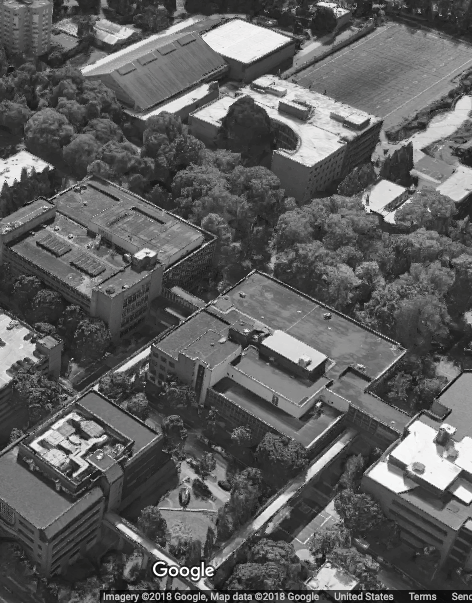…Within Pedestrian Sanctuary zones, place school campuses, distributed according to need.

__Problem-statement: School campuses too often turn their backs on the surrounding city or suburb, and create dead zones in the urban fabric as well as isolated, boring places for students.__
Discussion: Schools are certainly unique elements that have special requirements — among them safety for students, ample space for recreation, and sufficient size to provide for economies of management. Yet there is no fundamental reason that they must be isolated, or pose impenetrable barriers to the city.
Perhaps the best example of a necessarily large school is the university campus, which often must accommodate many thousands of students. Yet even large university campuses can be integrated directly into the walkable urban fabric, served by streetcars and other public transit, thus forming an integral part of the city separated from it by a semi-permeable (not solid) boundary.¹

Left, an isolated and boring university “supercampus” in Olympia, Washington, and right, a lively campus integrated into the urban fabric of Portland, Oregon. The latter campus is in a walkable, bikeable setting, and served by streetcar and other transit.
The special requirements of a campus give it even more urgent pedestrian needs. Every building generally needs vehicular access for services, but that must take second place to the pedestrian connectivity. An obsession with mono-functional zoning often forces all student dormitories on a campus to be clustered together, while all administrative functions are housed in a single, imposing building, etc. Yet functional segregation works against mixing and compactness, and does not produce an ideal learning environment.
__Therefore: Do not isolate school facilities and surround them with dead inactive edges, but weave them into the city fabric, providing stimulation to students and non-students alike. Wherever possible, put buildings on the edges, and where sports fields must go to the edges, build attractive pergolas and other structures to promote walkability. Assure that buildings are attractive at pedestrian scale, and offer interesting window views to surrounding streets.__

Assure that the school campuses have a Walkable Streetscape with a well-articulated Place Network...
notes
¹ It is helpful in this context to review patterns by Christopher Alexander and colleagues for a campus at the University of Oregon. See Alexander, C., Silverstein, M., Angel, S., Ishikawa, S., & Abrams, D. (1975). The Oregon Experiment, New York: Oxford University Press. The pattern descriptions given below are our own summaries:
Open University. Do not isolate the university by surrounding it with a boundary; instead, interweave at least one side of the campus into an adjoining city, if that is possible.
Student Housing Distribution. Locate some student housing within the center of the campus, with different percentages in regions as one moves away from the center. The first 500m radius containing ¼ of the resident students; ¼ in a ring between 500m and 800m radius; and the rest outside 800m.
University Shape And Diameter. If possible, situate classrooms within a central core of ½ km radius, and non-class activities such as administration, sports centers, and research offices outside.
Local Transport Areas. Give priority to pedestrian flow in the central core of the campus, within a radius of ½ - 1 km. Vehicular traffic here must be made to go on slow and circuitous roads.
Fabric Of Departments. While each academic department ought to have a home base, it should be able to spread over into other buildings and interlock with other departments.
For further reading see Salingaros, N.A. (2020). Planning, Complexity, and Welcoming Spaces — The Case of Campus Design. In Handbook on Planning and Complexity, De Roo, G., Yamu, C. and Zuidema, C. (Eds.) Cheltenham UK: Edward Elgar Publishers.
See more Special Use Patterns